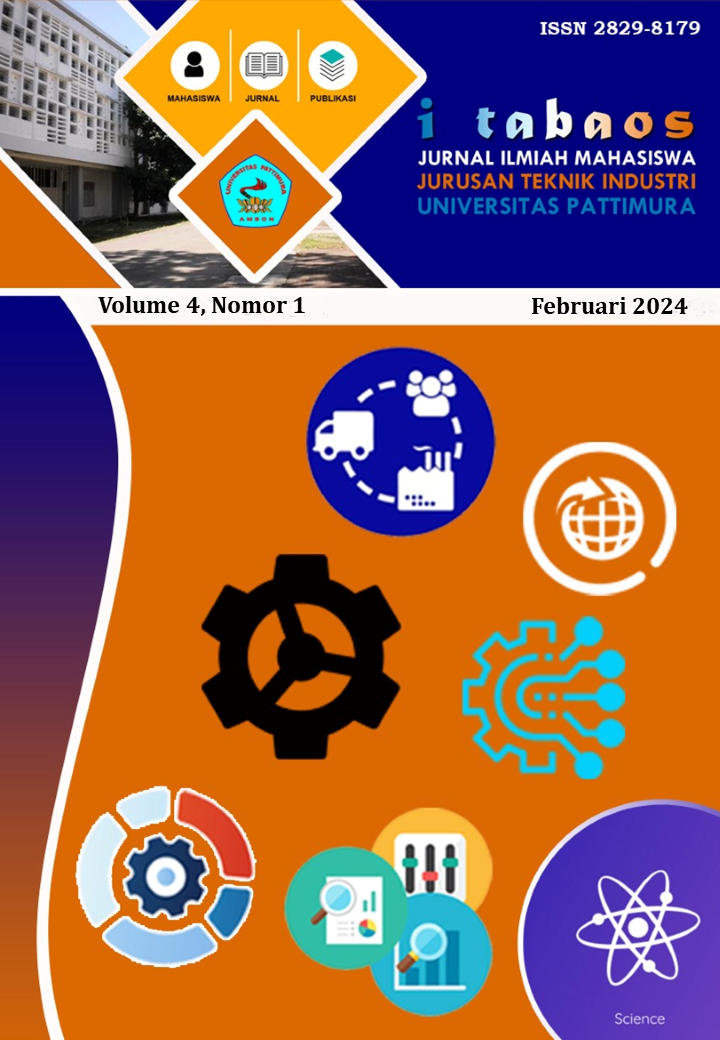OPTIMASI KEKASARAN PERMUKAAN UNTUK MENGURANGI AMPLITUDO GETARAN PADA STRUKTUR ALUMINIUM
Abstract
Penelitian ini bertujuan mengoptimalkan kekasaran permukaan pada dinding box aluminium untuk mengurangi amplitudo getaran akibat gaya eksitasi. Aluminium dipilih karena sifatnya yang ringan, kuat, dan tahan korosi, ideal untuk aplikasi industri. Metode simulasi dibantu komputer digunakan untuk menganalisis pengaruh berbagai tingkat kekasaran permukaan terhadap respons getaran struktur. Simulasi dilakukan pada model box aluminium polos dan bermotif horizontal serta vertikal dengan ketinggian 1mm dan 1,5mm. Hasil penelitian menunjukkan bahwa peningkatan kekasaran permukaan secara signifikan mengurangi amplitudo getaran. Motif dengan ketinggian 1,5mm lebih efektif mengurangi amplitudo dibandingkan motif 1mm. Selain itu, motif vertikal menunjukkan efisiensi redaman yang sedikit lebih tinggi dibandingkan motif horizontal. Penurunan amplitudo disebabkan oleh peningkatan gaya gesekan internal dan disipasi energi yang lebih efektif pada permukaan kasar. Temuan ini mendukung teori bahwa kekasaran permukaan dapat digunakan untuk mengontrol dan mengurangi respons dinamis pada struktur aluminium, meningkatkan kinerja dan keselamatan dalam aplikasi industri. Penelitian ini memberikan kontribusi penting dalam desain dan pemeliharaan struktur aluminium, khususnya dalam konteks industri di mana pengendalian getaran merupakan faktor krusial.
Downloads
References
Albany, A., Smith, B., & Johnson, C. (2019). Surface Roughness Effects on Structural Damping. Journal of Applied Mechanics, 85(5), 051008.
Dobes, J., Leal, JES., Profeta, J., & de Sousa, MM. (2017). Effect of mechanical vibration on Ra, Rq, Rz, and Rt roughness parameters. The International Journal of Advanced Manufacturing Technology, Springer. Retrieved from https://www.academia.edu/download/109100722/s00170-017-0137-020231217-1-uyyj6.
Gusti, I. K. (2018). Effect of Surface Roughness on the Vibration of Structures. International Journal of Engineering Research and Applications, 8(6), 30-36.
Hu, J., Shimizu, T., Yoshino, T., & Shiratori, T. (2018). Ultrasonic dynamic impact effect on deformation of aluminum during micro-compression tests. Journal of Materials, Elsevier. Retrieved from https://www.sciencedirect.com/science/article/pii/S0924013618301262.
Kim, J., Ha, H., Kim, K., & Jhang, K. (2020). Analysis of the Influence of Surface Roughness on Measurement of Ultrasonic Nonlinearity Parameter Using Contact-Type Transducer. Applied Sciences, 10(23), 8661.
Lekatompessy Debby R. (2023a). Local vibration reduction of machine support systems through transmissibility pattern analysis in resonant construction. AIP Conf. Proc. 23 January 2023; 2588 (1): 040012. https://doi.org/10.1063/5.0111908
Lekatompessy Debby R. (2023b); Analysis of the effect of engine rotation on vibration amplitude in the engine room of aluminum ship. AIP Conf. Proc. 23 January 2023; 2588 (1): 040014. https://doi.org/10.1063/5.0111911
Lekatompessy Debby R.(2023c); Analysis of rubber as reduction vibration material on FRP ship walls. AIP Conf. Proc. 23 January 2023; 2588 (1): 040007. https://doi.org/10.1063/5.0111899
Li, Q., Lu, K., Wu, K., Zhang, H., Sun, X., Wu, X., … & Xiao, D. (2021). A Novel High-Speed and High-Accuracy Mathematical Modeling Method of Complex MEMS Resonator Structures Based on the Multilayer Perceptron Neural Network. Micromachines, 12(11), 1313.
Liu, X., Wang, W., Jiang, R., Xiong, Y., Lin, K., & Li, J. (2020). Investigation on surface roughness in axial ultrasonic vibration–assisted milling of in situ TiB2/7050Al MMCs. The International Journal of Advanced Manufacturing Technology, Springer. Retrieved from https://link.springer.com/article/10.1007/s00170-020-06081-4.
Muñoz, A., Buenhombre, J., García-Diez, A., Fabal, C., & Díaz, J. (2020). Fatigue Study of the Pre-Corroded 6082-T6 Aluminum Alloy in Saline Atmosphere. Metals, 10(9), 1260.
Niu, Q., Jing, L., Wang, C., Li, S., Qiu, X., & Li, C. (2020). Study on effect of vibration amplitude on cutting performance of SiCp/Al composites during ultrasonic vibration–assisted milling. The International Journal of Advanced Manufacturing Technology, Springer. Retrieved from https://link.springer.com/article/10.1007/s00170-019-04796-7.
Puga, H., Grilo, J., & Carneiro, VH. (2019). Ultrasonic assisted turning of Al alloys: influence of material processing to improve surface roughness. Surfaces, MDPI. Retrieved from https://www.mdpi.com/2571-9637/2/2/24.
Şahinoğlu, A., Karabulut, Ş., & Güllü, A. (2017). Study on spindle vibration and surface finish in turning of Al 7075. Solid State Phenomena, Trans Tech Publications. Retrieved from https://www.scientific.net/SSP.261.321.
Sahoo, P., & Pratap, A. (2017). Modeling and optimization of surface roughness and tool vibration in CNC turning of Aluminum alloy using hybrid RSM-WPCA methodology. International Journal of Industrial Engineering Computations, Growing Science. Retrieved from http://growingscience.com/beta/ijiec/2458-modeling-and-optimization-of-surface-roughness-and-tool-vibration-in-cnc-turning-of-aluminum-alloy-using-hybrid-rsm-wpca-methodology.
Sun, X., Xu, X., Wang, Z., & Li, Y. (2021). Study on Corrosion Fatigue Behavior and Mechanism of 6005A Aluminum Alloy and Welded Joint. Anti-Corrosion Methods and Materials, 68(4), 302-309.
Tong, J., Zhao, J., Chen, P., & Zhao, B. (2020). Effect of ultrasonic elliptical vibration turning on the microscopic morphology of aluminum alloy surface. The International Journal of Advanced Manufacturing Technology, Springer. Retrieved from https://link.springer.com/article/10.1007/s00170-019-04463-x.
Copyright (c) 2024 Agustinus Sainly Titirloloby, Debby R. Lekatompessy, Sonja T. A. Lekatompessy

This work is licensed under a Creative Commons Attribution-ShareAlike 4.0 International License.
Penulis yang menerbitkan artikel di Jurnal i-TABAOS menyetujui persyaratan berikut:
- Penulis memegang hak cipta dan memberikan hak publikasi pertama dari karya yang dilisensikan secara bersamaan kepada Jurnal i-TABAOS, di bawah Lisensi Creative Commons Attribution-ShareAlike 4.0 yang memungkinkan orang lain untuk berbagi karya dengan pengakuan kepemilikan karya dan publikasi awal di jurnal ini.
- Penulis dapat membuat pengaturan kontrak tambahan yang terpisah untuk distribusi non-eksklusif dari versi jurnal yang diterbitkan (misalnya, mempostingnya ke repositori institusional atau menerbitkannya dalam sebuah buku) dengan pengakuan publikasi awal pada jurnal ini.
- Penulis diizinkan dan didorong untuk memposting karyanya secara online (misalnya, di repositori institusional atau di situs web mereka) sebelum dan selama proses pengiriman, karena dapat menghasilkan pertukaran yang produktif, serta kutipan yang lebih awal dan lebih besar dari karya yang diterbitkan (Lihat Pengaruh Akses Terbuka).
Baca lebih lanjut tentang Creative Commons Attribution-ShareAlike 4.0 Licence: https://creativecommons.org/licenses/by-sa/4.0/.




